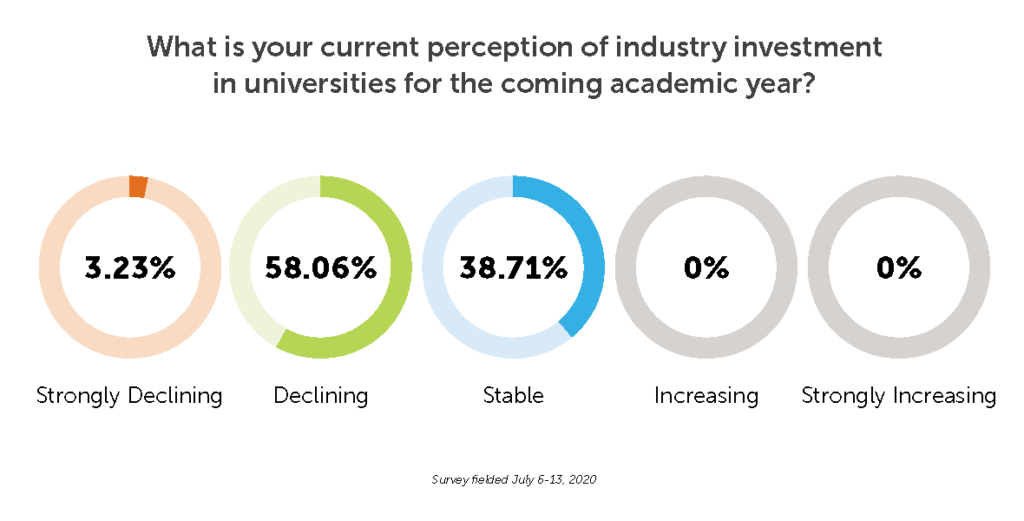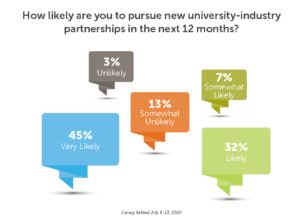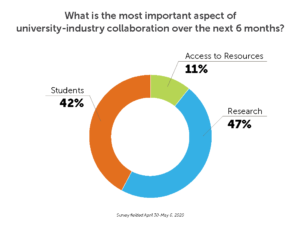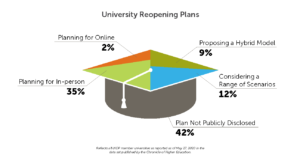UIDP COVID-19 Response Report
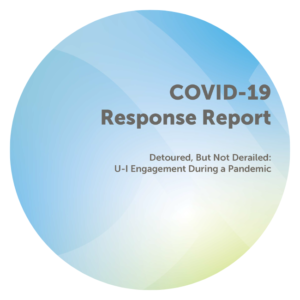 How companies and universities adapted and how the pandemic changed the partnership landscape.
How companies and universities adapted and how the pandemic changed the partnership landscape.
In the wake of the COVID-19 pandemic, UIDP hosted seven weekly calls to address challenges that arise from the need to shift from in-person meetings to remote collaboration approaches. The goal of these calls was to use a fast-lane approach to crowdsource ideas and solutions.
Using the findings from these discussions, UIDP created a report on how companies and universities adapted and what the university-industry partnership landscape looks like moving forward. This report references statistics and general findings from the discussion series hosted by UIDP from April 30 through June 11, 2020, including statistics from electronic surveys sent to UIDP members, polling, or free-form responses provided during the discussions. While not scientific surveys, the report information should be interpreted as an aggregation of the views of those working for large companies and research universities during the height of the pandemic while under widespread isolation directives.
10 Key Themes
I. Essential Research Continues
During what attendees called the ramp down, most university representatives estimated that only 10% to 25% of their on-campus research could continue. Experiments that could be performed remotely or in isolation were allowed to continue. Company representatives said that 80% to 100% of industry research was able to continue because it was either deemed essential or researchers were able to comply with social distancing and disinfecting requirements. Meanwhile, COVID-19–related research escalated wherever possible.
II. Impact of Work from Home
Although researchers who could not work from their labs produced record numbers of research proposals and journal submissions during this period, preliminary data from a reputable research university suggests that female researchers were not able to devote as much time to proposal writing as their male counterparts. Contracting personnel faced different challenges, such as shifting to an electronic signature process and the need to rapidly adopt new software and new processes.
III. Communication
For the most part, universities were the primary drivers of communication. The most substantive complaint about communication arose during a discussion about talent recruiting. Company representatives felt that they could not adequately plan for their recruiting season without knowing whether or not students would be on campus. Company representatives felt inhibited by the level of uncertainty and long timelines for university decision making specific to fall recruiting.
IV. No-Cost Extensions
Participants estimated that most research projects could absorb two months of working from home without issue. After that period, most projects would be impacted. Research projects nearing completion or having an overall duration of less than two years were the first to be evaluated and modified to address the lack of lab access. Many company representatives expressed a willingness to provide universities with no-cost extensions, especially to cover student support. These no-cost extensions (NCEs) solve short-term problems but will lead to funding shortfalls later.
V. Force Majeure
Most companies and universities strive to be flexible instead of enforcing force majeure. The expectation at the onset of the pandemic was that companies would invoke force majeure. Instead, force majeure was invoked by some universities when they felt that following through with their contractual commitments was impossible. Due to the uncertainty caused by coronavirus, representatives report that many new contracts now include clauses that address the challenges that came to light in 2020.
VI. Funding
Funding for U-I partnerships is expected to decrease in the next year. A large amount of research funding was available for COVID-19–related research, and by and large, companies were also honoring their existing financial commitments to universities, although restructuring payment timelines was common. While research funding levels are still not fully known, company representatives were transparent about the fact that recruiting budgets have been slashed significantly due to the larger economic downturn caused by the pandemic. The decline in state funding for higher education is another funding challenge. Many UIDP members are searching for low-cost ways to stay connected with their research partners.
Most companies and universities are working exclusively with their closest strategic partners; one-off or transactional U-I collaborations are largely on hold. However, most representatives expressed a willingness to pursue new partnerships.
VIII. Building Partnerships in a Virtual Work Environment
The pandemic has forced people to become more adaptable. Despite the technical challenges of working remotely, discussion participants felt that trust could be built via online-only relationships. An unexpected challenge is that online meetings tend to be very business focused. To build personal connections through online meetings, an intentional effort must be made.
Traditionally, the top three reasons for companies and universities to collaborate have been research, students, and access to resources (such as specialized equipment). Among participants in the COVID-19 Response Discussions, 42% said that student recruitment and access to talent would be the most important aspect of U-I collaboration in the next six months.
For companies, recruitment strategy has been impacted at all worldwide locations due to COVID-19, and they are strategizing for the future. Professionals in recruiting and workforce development emphasized the importance of employers staying present on university campuses and continuing to make connections with the future workforce.
One big challenge for companies is the uncertainty that they have around whether students will be on university campuses. The graphic here reflects public statements that UIDP member universities made at the time of the COVID-19 Response Discussion.
Related Resources
UIDP COVID-19 Weekly Response Call Notes
Access the notes and key takeaways from every call during UIDP’s weekly response discussions.
Additional Resources
The Effects of the COVID-19 Pandemic on How Universities Contribute to Innovation
Research from the University Commercialization & Innovation Policy/Evidence Unit at the University of Cambridge and the National Centre for Universities and Business exploring the impact of COVID-19 on the effects of the COVID-19 pandemic on the ability of universities to contribute to innovation through the crisis and into the economic recovery.
COVID-19 impact on research, lessons learned from COVID-19 research, implications for pediatric research
Recognizing and addressing challenges, opportunities, and strategies in order to navigate the research environment in the wake of the COVID-19 pandemic.
Mitigating Impacts to Research Activities Due to COVID-19
See the University of Washington’s response to the COVID-19 pandemic in accordance with Washington’s Safe Start plan.
Research & Innovation COVID-19 Impact
See how CU Boulder faculty, staff, and students from across are discovering and creating new and innovative ways to address the challenges posed by the COVID-19 pandemic.
The Coronavirus Crisis: What Manufacturers are Saying – and Doing
See how manufacturers from a diverse set of industries are responding to the COVID-19 pandemic.



